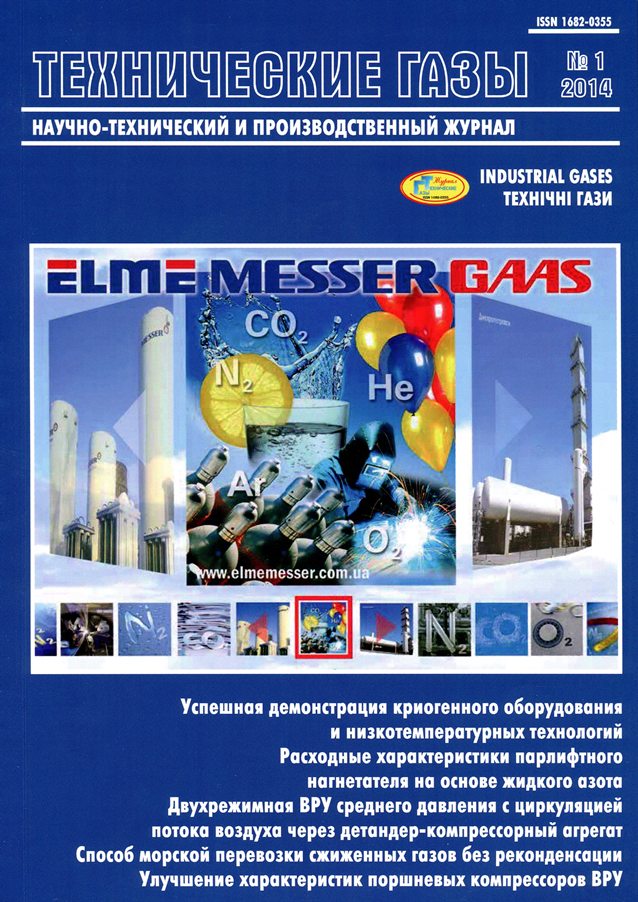NON-CRYOGENIC SEPARATION METHOD NEON HELIUM MIXES
DOI:
https://doi.org/10.18198/j.ind.gases.2014.0711Keywords:
Separation, Gas mixture Ne-He, Helium, Membrane, Cenospheres, Unsteady operationAbstract
The new type of devices for the membrane division of gaseous mixtures is the devices, working in the non-stationary mode. A dividing membrane in such devices has a form of the closed microcapsule. The microscopic shells of such capsules provide high-rate of diffusion of gases, unattainable in devices working in the stationary mode. Methodology of calculation of devices for the membrane division of gaseous mixtures, working in the non-stationary mode is offered. A calculation is making by decomposition of entrance concentration signal in the row of Fourier for the eigenfrequencies of this device. Thus each of eigenfrequencies regardless of other, transmited through the layer of microcapsules, and on exit from this layer all decisions for separate eigenfrequencies are added up. On the concrete example of division of neon-helium mixture, efficiency of the offered model is shown. Demonstrated that a single transmission neon-helium mixture through an installation with two devices, 2 m long, filled cenospheres can reduce the concentration of helium is almost an order of magnitude.
References
Dytnersky Y.I., Brykov V.P., Kagramanov G.G. (1991). Membrane separation of gases. — Moscow.: Chemistry. — 344 p. (Rus.).
Dolgushev S.V., Fomin V.M. (2008). Enrichment of natural gas helium in unsteady diffusion-sorption processes in a layer of glass microspheres// Vuchislitelnaya mekhanika sploshnuh sred. [Computational Continuum Mechanics]. — V. 1. — No. 3. — P. 66-75. (Rus.).
Dolgushev S. V., Fomin V. M. (2003). Helium: its significance for industry; today’s and tomorrow’s methods of its extraction// Preprint ITAM SB RAS. — No. 5. — 23 p.
Vereshchagin A. S., Vereshchagin S. N., Fomin V. M. (2007). Mathematical modeling of motion of the helium concentration pulse over a column filled with cenospheres// J. Appl. Mech.Tech. Phys. — V. 48. — No. 3. — P. 92-102.
Chernikh J.J., Vereshchagin S. N. (2011). Investigati-on of helium permeability narrow fraction of cenospheres energy ashes// Zhurnal Sibirskogo federalnogo universiteta. Himiya. 2. [Journal of Siberian Federal University. Chemistry. 2]. — No. 4. — P. 135-147. (Rus.).
Vereshchagin A. S., Zinoviev V. N., Pak A. Yu, et al. (2010). Estimation of the permeability coefficient of microsphere walls// Vestn. NGU. Ser. Fizika, — V. 5. — No. 2. — P. 8-16. (Rus.).
Kravchenko M.B. (2011). The adsorption wave. Analytical description and analysis of processes// Teckhnicheskie Gazy. [Industrial Gases]. — № 5. — P.49-59. (Rus.).
Kartashow E.M. (1985). Analytical methods in the theory of thermal conductivity of solids. — Moscow: Higher School. — 480 p. (Rus.).
Aerov M.E., Todes O.M. (1968). Hydraulic and thermal basics of vehicles with fixed and fluidized granular layer. — Leningrad: Khimiya. — 512 p. (Rus.).
Vereshchagin S. N., Kurteeva L. I., Rabchevskaya A. A. Using cenospheres of volatile ashes from burning coal for diffuse separation of gases, in processes of combustion and explosion in physical chemistry and technology of inorganic materials// Proc. All-Russia conf. — Moscow. — 2002. — P. 70.
Downloads
Issue
Section
License
LICENSE AGREEMENT
After receiving an article for publication as required revision scientometric databases each author directs the license agreement on the assignment and transfer of the management of copyright. Signatures of the author (s) it is desirable to seal the personnel department of the institution where the author works (authors), or the seal of the Faculty.
Revision refers to the authors one layout for proofreading. Permissible only those fixes that result in compliance with the layout of the original text of the article. Significant changes are not permitted. Layout should be sent to the editorial office within days of receipt.

